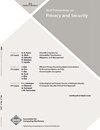Pareto-optimal Defenses for the Web Infrastructure: Theory and Practice
IF 2.8
4区 计算机科学
Q2 COMPUTER SCIENCE, INFORMATION SYSTEMS
引用次数: 1
Abstract
The integrity of the content a user is exposed to when browsing the web relies on a plethora of non-web technologies and an infrastructure of interdependent hosts, communication technologies, and trust relations. Incidents like the Chinese Great Cannon or the MyEtherWallet attack make it painfully clear: the security of end users hinges on the security of the surrounding infrastructure: routing, DNS, content delivery, and the PKI. There are many competing, but isolated proposals to increase security, from the network up to the application layer. So far, researchers have focused on analyzing attacks and defenses on specific layers. We still lack an evaluation of how, given the status quo of the web, these proposals can be combined, how effective they are, and at what cost the increase of security comes. In this work, we propose a graph-based analysis based on Stackelberg planning that considers a rich attacker model and a multitude of proposals from IPsec to DNSSEC and SRI. Our threat model considers the security of billions of users against attackers ranging from small hacker groups to nation-state actors. Analyzing the infrastructure of the Top 5k Alexa domains, we discover that the security mechanisms currently deployed are ineffective and that some infrastructure providers have a comparable threat potential to nations. We find a considerable increase of security (up to 13% protected web visits) is possible at a relatively modest cost, due to the effectiveness of mitigations at the application and transport layer, which dominate expensive infrastructure enhancements such as DNSSEC and IPsec.网络基础设施的帕累托最优防御:理论与实践
用户在浏览网页时所接触到的内容的完整性依赖于大量的非网页技术和由相互依赖的主机、通信技术和信任关系组成的基础设施。像中国大炮或MyEtherWallet攻击这样的事件痛苦地表明:最终用户的安全性取决于周围基础设施的安全性:路由,DNS,内容交付和PKI。从网络到应用层,有许多相互竞争但相互孤立的提高安全性的建议。到目前为止,研究人员一直专注于分析特定层的攻击和防御。鉴于网络的现状,我们仍然缺乏对如何将这些建议结合起来的评估,它们的有效性如何,以及安全性的提高需要付出多大的代价。在这项工作中,我们提出了一种基于Stackelberg规划的基于图的分析,该分析考虑了丰富的攻击者模型以及从IPsec到DNSSEC和SRI的众多建议。我们的威胁模型考虑了数十亿用户对从小型黑客组织到民族国家行为者的攻击的安全性。分析前5k Alexa域名的基础设施,我们发现目前部署的安全机制是无效的,一些基础设施提供商对国家具有相当的威胁潜力。我们发现,由于应用程序和传输层的缓解措施的有效性,可以以相对适度的成本大幅提高安全性(受保护的web访问高达13%),这主要是昂贵的基础设施增强,如DNSSEC和IPsec。
本文章由计算机程序翻译,如有差异,请以英文原文为准。
求助全文
约1分钟内获得全文
求助全文
来源期刊

ACM Transactions on Privacy and Security
Computer Science-General Computer Science
CiteScore
5.20
自引率
0.00%
发文量
52
期刊介绍:
ACM Transactions on Privacy and Security (TOPS) (formerly known as TISSEC) publishes high-quality research results in the fields of information and system security and privacy. Studies addressing all aspects of these fields are welcomed, ranging from technologies, to systems and applications, to the crafting of policies.
 求助内容:
求助内容: 应助结果提醒方式:
应助结果提醒方式:


